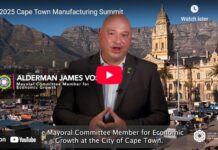By Chris Hattingh
Over the course of the first five months of 2025, United States (US) President Donald Trump and his administration have worked – mostly using the threat of higher US tariffs on trading partners – to reform global trade. A 10% universal tariff baseline has been established; what remains are the various levels of reciprocal tariffs imposed on individual countries, with much dependent on those governments meeting with US officials to secure a (relatively) more favourable arrangement for their exports to the US.
US tariffs 2025 hit South African exports hard
South Africa faces a 31% reciprocal tariff rate; the looming deadline for deals around the rate is 9 July, with Mr Trump indicating in mid-May that the US does not expect to meet with every trading partner before then. With the domestic agricultural, automotive, and mining sectors especially benefitting from South Africa’s Africa Growth and Opportunity Act (AGOA) preferential access to US markets before 2025, Mr Trump’s repeated shocks to the global trading system have rocked the South African government and these sectors onto the backfoot.
Between January and April of 2025, the average effective US tariff rate rose from 2.5% to around 27%. From traditional US allies such as the United Kingdom and Canada to its main geopolitical rival, China, various tariff levels were imposed.
US tariffs 2025 drive policy panic across markets
As a tool in his kit for negotiating new trade and investment terms with various countries, Mr Trump’s administration will likely continue using tariffs throughout his second term.
The major impact of this radical attempted change to global trade is the phenomenon of uncertainty. For importers and exporters, as well as businesses (from agriculture to manufacturing and everything in between), increased uncertainty dampens economic activity. Investments that were set may be delayed, or recalibrated and redirected entirely.
For manufacturing and construction, delays of indeterminate timeliness of materials and components result. For consumers, higher costs and shortages are possible, at least in the short term. Overall, global economic activity is affected. In its April 2025 World Economic Outlook, the International Monetary Fund highlighted: “The global economic system under which most countries have operated for the last 80 years is being reset, pushing the world into a new era. Existing rules are challenged while new ones are yet to emerge.”
Global risk premiums shift investment priorities
With elevated uncertainty comes elevated risk; in 2025 even the US Dollar and US Treasuries are being questioned as relatively riskier than before. Those countries with a higher risk premium – where investors demand higher returns to buy assets and equities in those countries, and to invest more capital and fixed assets – will not be able to take advantage of this moment of accelerated global trade and investment changes. Should the Government of National Unity (GNU) dither on necessary logistics reforms that shake up vested interests, this exceedingly rare opportunity in global trade will pass South Africa by.
Changes to global trade rules, and goods and investment flows, will continue through the rest of President Trump’s term and into the latter half of this decade. South Africa is geographically and geostrategically ideally placed to benefit. Its role as a major integrator of the Africa Continental Free Trade Area also plays to its favour. However, should the GNU dither on fundamental reforms in the logistics space, the country will fall further behind peers’ growth rates.
US tariffs 2025 demand modern infrastructure for trade success
But to take advantage of any such shifts, the country’s trade infrastructure must be modernised and fit for purpose; this infrastructure includes functional ports, railways, border posts, and roads. The associated systems and digital infrastructure require extensive investment and reform. Non-tariff barriers, such as high crime rates, must be tackled head on. On the trade policy side, never-ending subsidies and protections for local industry cannot continue; where such are implemented, they must be time-bound.
Those countries that build, and earn an international reputation for, reliable, safe domestic trade infrastructure and lower tariff barriers to trade and investment will benefit over the longer term from the various changes to global trade that are taking place in 2025.
It is unlikely that the US will return to the 145% tariff rate it imposed on China earlier this year; the potential damage to the US economy and bond yields was too great. Regardless, countries and businesses are unsure of the picture after 9 July. As such, the backbone of global trade, the shipping industry, is already shifting wherever possible to trade routes that are subject to relatively less politically motivated turbulence.















